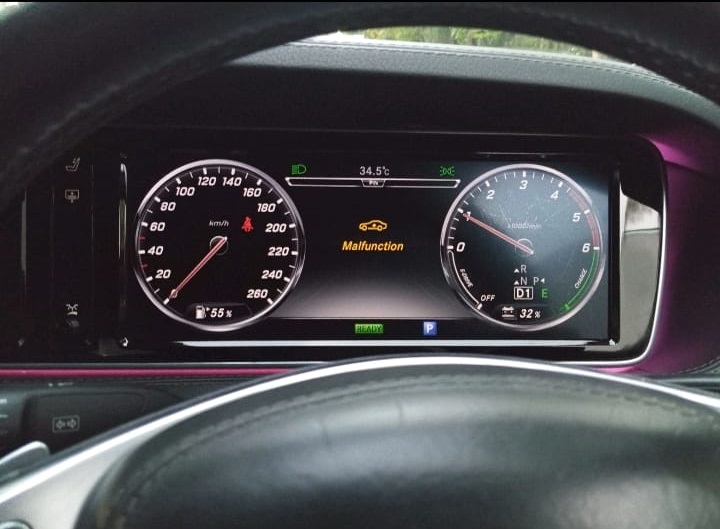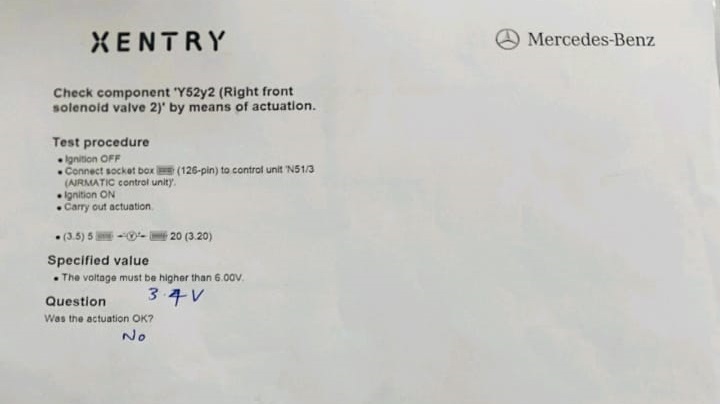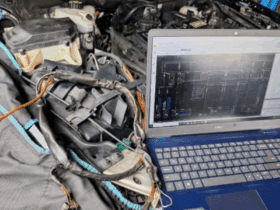Table of Contents
Resolving Mercedes Air Suspension Malfunction in the S-Class W222
The Mercedes-Benz S-Class W222 is a flagship luxury sedan known for its smooth ride, advanced technology, and comfort. A major part of that luxury feel comes from its AIRMATIC air suspension system, which uses air springs, adaptive dampers, and electronic control units to deliver an unmatched driving experience.
When the dashboard displays a “Mercedes Air Suspension Malfunction” warning, it is more than just an alert it signals a deeper issue within the suspension system. Left unresolved, these faults can lead to uneven ride height, poor handling, reduced comfort, and even safety concerns.
This article will walk you through the common causes, key symptoms, diagnostic process, and repair solutions for air suspension malfunctions in the Mercedes S-Class W222. We’ll also explore a real-world case study of a W222 with defective damping valves and how it was successfully diagnosed and repaired.
Common Causes of Mercedes Air Suspension Malfunction
Mercedes S-Class W222 owners may encounter several underlying faults when this warning appears:
- – Air leaks in air springs or hoses → gradual sagging or uneven ride height.
- – Compressor failure → inability to raise or maintain suspension pressure.
- – Valve block problems → improper air distribution across struts.
- – Damping valve malfunction → rough ride, switching between comfort/sport modes unexpectedly.
- – Sensor faults → incorrect ride-height or pressure readings.
- – Wiring harness or control unit issues → loss of communication with suspension components.
Symptom – Cause – Fix Table
| Symptom | Likely Cause | Recommended Fix |
|---|---|---|
| Dashboard warning: “Air Suspension Malfunction” | Faulty control unit / wiring harness | Perform diagnostic scan, repair wiring, reprogram control unit |
| Uneven ride height (one side lower) | Leaking air spring or faulty valve block | Replace leaking air spring, check valve block |
| Vehicle stuck in “Sport” mode | Damping valve malfunction in struts | Replace defective front struts with damping valves |
| Rough or bouncy ride | Failed shock absorber or damper control | Inspect dampers, replace faulty units |
| Suspension not rising after start | Compressor failure / blown fuse | Replace compressor, check relay and fuse |
| Warning appears after software update | Coding or calibration error | Re-code AIRMATIC control unit, recalibrate ride height |
Case Study: Mercedes S-Class W222 Air Suspension Problem
Customer Complaint
The owner of a Mercedes-Benz S550 (W222) reported that the suspension system would automatically switch from comfort mode to sport mode, accompanied by a suspension malfunction warning. The issue persisted despite attempts to reset the system, requiring a full diagnostic investigation.


Step 1: Initial Diagnostics
- – Performed a quick test with Xentry Diagnostics.
- – Retrieved two fault codes stored in the AIRMATIC control unit.
- – Faults indicated damping valve malfunctions in both front air suspension struts.
Step 2: Detailed Testing Procedure
A. Control Unit & Socket Box Check
- – Removed the AIRMATIC control unit.
- – Connected a special socket box for deeper measurements.
- – Verified that both front damping valves had correct supply voltage (14.01V).
- – Checked resistance of the wire harness (7 ohms, within normal range).


B. Output Voltage Check
- – Tested output voltages of damping valves.
- – Expected: >6V.
- – Actual: below 6V or zero → confirmed solenoid malfunction inside damping valves.
- – Verified that the supply voltages to both front damping valves were correct (14.01V).
- – Checked the resistance of the wire harness for both damping valves (7 ohms).



Step 3: Resolution Steps
1. Erased Fault Codes & Performed Software Update
- – Cleared all stored faults.
- – Updated software for drivetrain and AIRMATIC control units.
2. Test Drive
- – Road tested vehicle.
- – Fault codes reappeared, confirming that updates alone could not resolve issue.
3. Final Diagnosis
- – Concluded that both front AIRMATIC struts had defective damping valves.
- – Recommended replacement of both struts.
Repair Process for AIRMATIC Strut Replacement
- 1. Preparation
- – Vehicle safely lifted and battery disconnected.
- – Xentry used to depressurize air suspension system.
- 2. Component Removal
- – Removed front wheels.
- – Disconnected airline fittings and electrical connectors.
- – Unbolted defective struts.
- 3. Replacement
- – Installed new AIRMATIC struts with integrated damping valves.
- – Ensured proper torque on suspension bolts.
- 4. Calibration & Coding
- – Reconnected system and cleared fault codes.
- – Performed AIRMATIC ride-height calibration via Xentry.
- 5. Final Checks
- – Road tested vehicle in both Comfort and Sport modes.
- – No warnings appeared; ride quality restored.
Explore More Mercedes Suspension Issues
For a deeper dive into suspension problems such as uneven ride height, AIRMATIC malfunctions, “Stop Vehicle Too Low” warnings, and vibration faults, visit our hub: Mercedes-Benz Suspension Issues – Symptoms, Causes & Fixes. There you’ll find grouped case studies, step-by-step diagnostics, symptom, cause, fix tables, and preventive tips to keep your Mercedes riding smoothly.
Why the AIRMATIC System Malfunctions
The AIRMATIC suspension system in the Mercedes W222 relies on a network of air springs, electronic dampers, valve blocks, sensors, and control units. Any single failure can trigger the system to default into “malfunction” mode, warning the driver and disabling comfort features.
In this case, the damping valves inside the struts failed electronically, forcing the suspension to switch into sport mode and triggering the warning.
Prevention & Maintenance Tips
- – Regularly inspect air springs and hoses for leaks.
- – Check compressor function if the vehicle struggles to rise.
- – Protect wiring harnesses from rodent damage.
- – Perform STAR/Xentry calibration after any suspension repair.
- – Avoid driving long-term with a warning light minor issues can cause major failures if ignored.
FAQs
Q: What is the Mercedes AIRMATIC malfunction?
A: It’s a fault within the air suspension system, indicating that one or more components (air springs, valves, sensors, compressor, or dampers) are not functioning correctly.
Q: Can I drive with the suspension malfunction warning?
A: While the car may remain drivable, ride comfort and safety are compromised. Prolonged driving can cause further damage, so prompt repair is recommended.
Q: How much does it cost to repair Mercedes air suspension?
A: Costs vary. Replacing an AIRMATIC strut can range from $1,200–$2,500 per unit at a dealership. Independent workshops may offer more affordable solutions.
Q: How long do AIRMATIC struts last?
A: On average, 80,000–100,000 miles depending on driving conditions and maintenance.
Q: Do I need to replace both struts at once?
A: Yes, for balance and performance, it’s recommended to replace both front or both rear struts together.
Conclusion
Dealing with a Mercedes air suspension malfunction in the S-Class W222 requires a methodical approach: start with diagnostics, confirm voltage and resistance values, check damping valves, and test output voltages. In this case study, the root cause was traced to defective damping valves in the front AIRMATIC struts, which were resolved by replacing both components and performing proper calibration.
Author
Written by Mercedes Expert
With years of hands-on experience diagnosing and repairing Mercedes-Benz systems, he brings technical depth and practical case studies to help car owners, technicians, and enthusiasts troubleshoot complex automotive issues. His work focuses on clear repair guides, OEM-level procedures, and knowledge-sharing to empower both professionals and drivers.
Last Updated: September 2025
— Salim, Mercedes Expert
Independent specialist in Mercedes-Benz diagnostics, CAN Bus analysis, troubleshooting case studies, and EV systems.







Leave a Reply